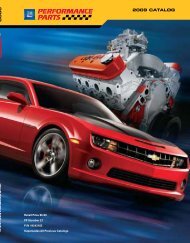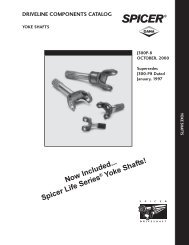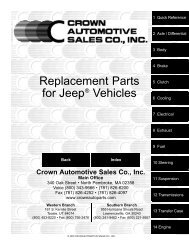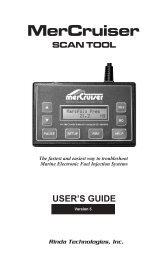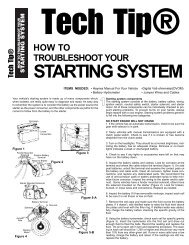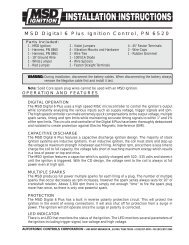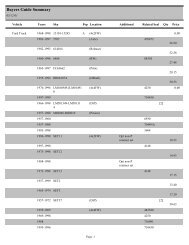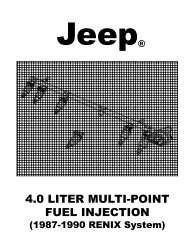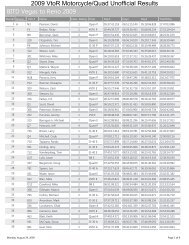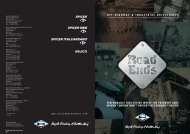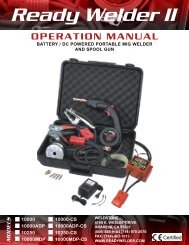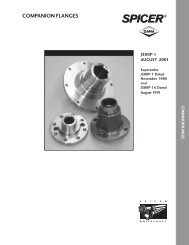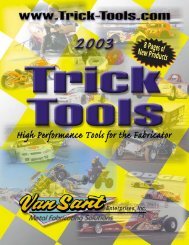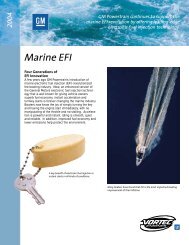Ball and Roller Bearings - Ntn-snr.com
Ball and Roller Bearings - Ntn-snr.com
Ball and Roller Bearings - Ntn-snr.com
Create successful ePaper yourself
Turn your PDF publications into a flip-book with our unique Google optimized e-Paper software.
Lubrication<br />
11. Lubrication<br />
11.1 Lubrication of rolling bearings<br />
The purpose of bearing lubrication is to prevent direct<br />
metallic contact between the various rolling <strong>and</strong> sliding<br />
elements. This is ac<strong>com</strong>plished through the formation of a<br />
thin oil (or grease) film on the contact surfaces. However,<br />
for rolling bearings, lubrication has the following<br />
advantages:<br />
(1) Friction <strong>and</strong> wear reduction<br />
(2) Friction heat dissipation<br />
(3) Prolonged bearing life<br />
(4) Prevention of rust<br />
(5) Protection against harmful elements<br />
In order to achieve the above effects, the most effective<br />
lubrication method for the operating conditions must be<br />
selected. Also, a good quality, reliable lubricant must be<br />
selected. In addition, an effectively designed sealing<br />
system that prevents the intrusion of damaging elements<br />
(dust, water, etc.) into the bearing interior, removes dust<br />
<strong>and</strong> other impurities from the lubricant, <strong>and</strong> prevents the<br />
lubricant from leaking to the outside, is also a<br />
requirement.<br />
Almost all rolling bearings use either grease or oil<br />
lubrication methods, but in some special applications, a<br />
solid lubricant such as molybdenum disulfide or graphite<br />
may be used.<br />
Fig. 11.1 shows the relationship between oil volume,<br />
friction loss, <strong>and</strong> bearing temperature. Table 11.1 details<br />
the characteristics of this relationship.<br />
11.2 Lubrication methods <strong>and</strong> characteristics<br />
The lubrication methods <strong>com</strong>e in two general<br />
methods: you must be care for select of that from using<br />
condition.<br />
The characteristic are show in table 11.2.<br />
Table 11.2 Comparison of grease lubrication <strong>and</strong><br />
oil lubrication characteristics<br />
high<br />
Temperature<br />
increase<br />
high<br />
Concern<br />
H<strong>and</strong>ling<br />
Method<br />
Grease<br />
lubrication<br />
<br />
Oil lubrication<br />
<br />
Temperature increase<br />
A<br />
B<br />
C<br />
D<br />
Oil volume<br />
Friction loss<br />
great<br />
E<br />
Friction loss<br />
Reliability<br />
Cooling effect<br />
Seal structure<br />
Power loss<br />
Environment contamination<br />
High speed rotation<br />
<br />
<br />
<br />
<br />
<br />
<br />
<br />
(Circulation<br />
necessary)<br />
<br />
<br />
<br />
<br />
Very goodGoodFairPoor<br />
Fig. 11.1<br />
Table 11.1 Oil volume, friction loss, bearing temperature<br />
(See Fig. 11.1)<br />
Range Characteristics Lubrication method<br />
A<br />
B<br />
C<br />
D<br />
E<br />
When oil volume is extremely low,<br />
direct metallic contact occurs in places<br />
between the rolling elements <strong>and</strong><br />
raceway surfaces. Bearing abrasion<br />
<strong>and</strong> seizing occur.<br />
A thin oil film develops over all<br />
surfaces, friction is minimal <strong>and</strong><br />
bearing temperature is low.<br />
As oil volume increases, heat buildup<br />
is balanced by cooling.<br />
Regardless of oil volume, temperature<br />
increases at a fixed rate.<br />
As oil volume increases, cooling<br />
predominates <strong>and</strong> bearing temperature<br />
decreases.<br />
<br />
Grease lubrication,<br />
oil mist,<br />
air-oil lubrication<br />
Circulating<br />
lubrication<br />
Circulating<br />
lubrication<br />
Forced circulation<br />
lubrication,<br />
Oil jet lubrication<br />
11.3 Grease lubrication<br />
Grease type lubricants are relatively easy to h<strong>and</strong>le <strong>and</strong><br />
require only the simplest sealing devices-for these<br />
reasons, grease is the most widely used lubricant for<br />
rolling bearings.<br />
11.3.1 Types <strong>and</strong> characteristics of grease<br />
Lubricating grease are <strong>com</strong>posed of either a mineral oil<br />
base or a synthetic oil base. To this base a thickener <strong>and</strong><br />
other additives are added. The properties of all greases<br />
are mainly determined by the kind of base oil used <strong>and</strong> by<br />
the <strong>com</strong>bination of thickening agent <strong>and</strong> various<br />
additives.<br />
St<strong>and</strong>ard greases <strong>and</strong> their characteristics are listed in<br />
Table 11.3. As performance characteristics of even the<br />
same type of grease will vary widely from br<strong>and</strong> to br<strong>and</strong>,<br />
it is best to check the manufacturers' data when<br />
selecting a grease.<br />
A-70



